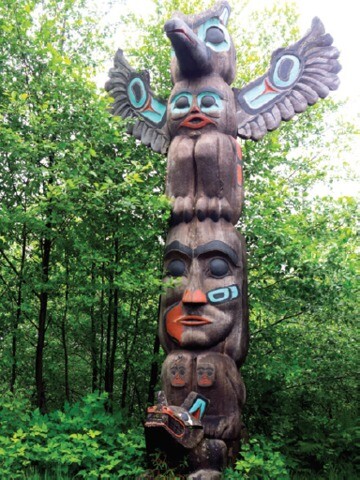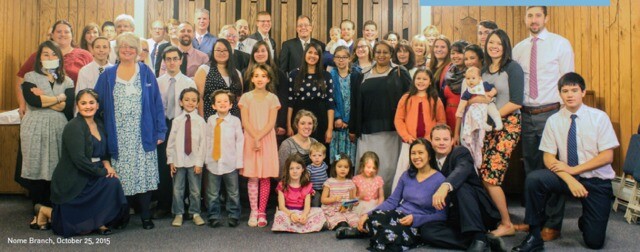The story of how the Church came to be in the cold, northern climate of Alaska is truly the story of one man—one man and a series of remarkable firsts.
Born in Shelbyville, Kentucky, in 1824, Dr. Edward G. Cannon lived an adventurous life, serving in the Mexican War, prospecting for gold, and practicing medicine. He finally ended up in Utah with his wife in 1871. While in Utah, Cannon embraced the LDS faith. At the turn of the century, the then-76-year-old widower, again in search of gold, immigrated to Nome, Alaska, and brought his religion with him. It was said that Cannon “maintained a chapel on wheels, which he called a tabernacle, in which meetings were held in various camps in the province.”
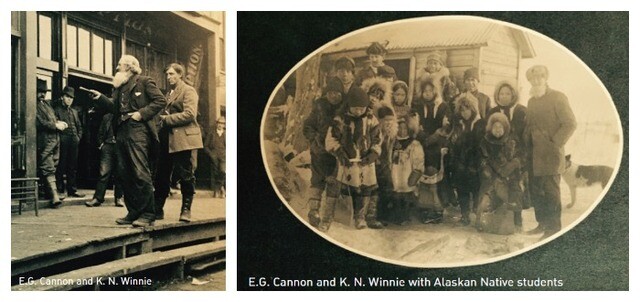
The First Baptisms
During one of these meetings, Cannon shared the gospel with a man by the name of Kedzie Noble Winnie. Winnie became a dear friend of Cannon and was baptized by him in the Bering Sea on June 25, 1902. According to Winnie’s 94-year-old daughter, Della Wood, her father found something that was “more precious than gold.”
As the first LDS convert in Alaska, Winnie joined forces with Cannon to do missionary work and open the first known “Eskimo school” during the years 1903 and 1904, where they taught English and the gospel. The local newspaper, the Nome Daily Nugget, even printed advertisements such as this one, published in December 1908 under a listing of church services in Nome: “Gospel meetings every Sunday at 2 and 7:30 p.m. in the Nome Soup House. All are welcome to attend. E. G. Cannon, K. N. Winnie.”
Notwithstanding their tenacity, it appears that this missionary pair did not yield a great harvest. In a letter published by an LDS periodical in 1910, Cannon and Winnie described their missionary labors in Nome as follows: “We are holding meetings here as usual, but infidelity is increasing, and it seems very difficult to reach the church-goers. The pleasures of the world seem to be all satisfying to hundreds of the population in this city, but we are not giving up the fight, but rather continue to send out our warning voices while we are here.”
However, the missionary pair drew a lot of media attention with Nome’s first public LDS baptism of a woman. The Nome Daily Nugget published the following account, titled “Hundreds Gather to See Woman Baptized,” on September 19, 1910, wherein many Nome citizens gathered at Barracks Square to witness this unique event: “Mrs. A. W. [Nancy] Anthony was dipped below the icy waters of Bering Sea . . . the first woman convert to the faith of the Latter Day Saints here in Nome. . . . All the people who could get away at the hour of 2 in the afternoon were on hand to see how they did it.”
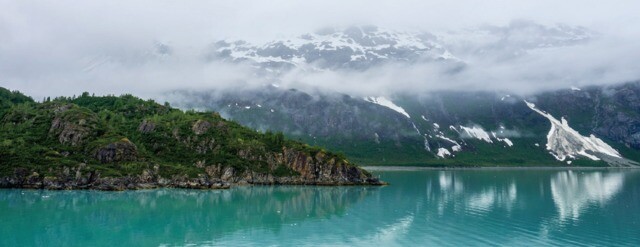
Growth Despite a Great Loss
From several articles that appeared in the Nugget a few weeks later, it appears that the baptism Cannon performed in the frigid waters ultimately caused his death, as a severe cold struck the aged man. On November 18, 1910, one editorial, titled “Dr. Cannon Holding His Own,” captured the tender feelings of the community: “We trust that the doctor will be spared to us for many more years, for he is very closely associated with the camp and the sight of a pure Christian person like the doctor is beneficial in any camp where one is so intent on chasing the American dollar that they have little time to think of other matters.”
Notwithstanding such hopes, Cannon expired a few days later on November 21, 1910, at the home of his adopted daughter, Grace Eva Riggs, who lived above the local post office.
As for Winnie, he continued his gospel labors in Nome for three years, which included writing articles about the Latterday Saint faith, published in the Nugget, and then later moved to Utah.
In Nome today, there is a branch of The Church of Jesus Christ of Latter-day Saints numbering over 100 members. Currently there are over 33,500 Church members in Alaska, organized in 62 wards, 26 branches, and 8 stakes. Since the first stake was organized in 1961, the Church in Alaska has seen influxes in membership, helped by the state’s growing population and the discovery of oil in this rich, frozen land. Alaskans have also seen an official mission organized and a temple dedicated in Anchorage at the close of the millennium on January 9, 1999.
Isolated but United
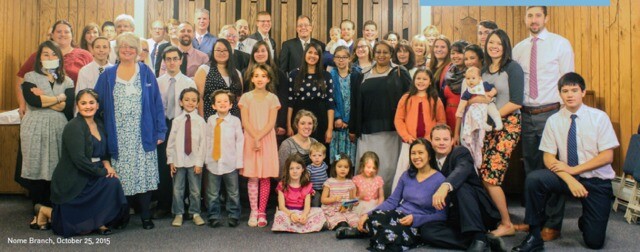
Alaska is a wide expanse of land with hundreds of miles between cities.
Longtime members Dr. David Head and his wife, Lori, live in Nome—one of the most isolated cities in all of Alaska, 120 miles away from Russia and 600 miles away from Anchorage. No roads go in or out of Nome. Anyone wanting to go anywhere has to travel by air or sea. Here David Head runs a family practice that helps meet the needs of the community.
Nome only has a population of about 4,000, so the members in the town are very well acquainted. “We’re able to watch out for each other a lot more than most are,” says David Head. “It’s more of a family than a branch because we’re so close to each other. It’s very service-oriented.”
“Members are willing to help with anything,” adds Angela Parker, a sister from the Eielson Ward in North Pole. “We go out in the cold to attend our meetings and help our neighbors. When the power goes out in the winter, everyone works together to make sure ward members are safe and warm.”
Despite these efforts to serve each other and stay connected, distance can still make it difficult to gather—especially for the young single adults.
“Depending on the year and season, we’ve had anywhere from 20 to 80 active members [in my young single adult branch],” shares Denali Lathrop, a member from North Pole, Alaska. And there are several hundred more who could be part of the branch. But, as Lathrop explains, distance and weather can make it difficult to get together with friends or even attend Sunday meetings. However, Lathrop adds, “Those who come try to really become a family and support one another.”
The communities and branches aren’t the only small things in the vast state, however. So are the meetinghouses.
Lathrop remembers the tiny Salcha Branch building she and her family used to attend when she was growing up. When the branch suddenly acquired a few more families, the members unexpectedly found themselves out of room. “Space was so limited that we did the only plausible things; during the summer we had the Priesthood classes meet outside and one Primary class met in the baptismal font—after putting up a sturdy board for a floor,” Lathrop recalls. And though they were later able to expand the building, other branches continue to do the best with what they have, including the Tamarack Branch, which meets in a rented building the size of an apartment.
Thankfully, modern technology and social media have given members a new opportunity to connect, even if they can’t always meet together. “We recognize the importance of the sacrament and of family,” Lathrop says. “We try to strengthen each other and learn in other ways. For instance, stake conferences are held over the internet because the stake president sometimes lives more than 600 miles away.”
“I think the growth of the Church here has been remarkable,” says Kirk Thomas, a member in Ketchikan who fell in love with Alaska while on a fishing trip and never left. “When my wife and I came here, there was one stake in Anchorage, and we had the privilege to go to Fairbanks and participate when the second stake was created, and that was huge.”
Facing the Frigid Temperatures with Faith
The extreme temperatures in the Alaskan wilderness sometimes pose a physical threat. But the faith of the members is strong and courageous—characteristics likely acquired by living in such an unforgiving environment. “A little snow doesn’t stop us,” says Parker.
“The Saints in Alaska are very committed, very loyal, and have great spiritual strength,” says Mel Perkins, a former Area Seventy for Alaska who now lives in Juneau part of the year. “There are some amazing families who have set that priority, and it’s generational.”
For many, temple attendance can be a challenge. “I know some families who have a set time each month that they travel the 350+ miles to the temple, even if they are only able to do an endowment session and then must turn around and come back to Fairbanks,” shares Lathrop.
The sparse, isolated population of Alaska presents an unusual situation to missionaries in the state as well. Lathrop shares, “Most missionaries cover two or three wards, but they usually cover at least five or so miles—sometimes 60 or more in outlying areas and branches.”
Along with the challenges of freezing temperatures and snow is the challenge of long days of darkness.
“In the winter, we go to church when it’s completely dark out,” says Brother Head. In North Pole, Lathrop shares, “We have a cold weather policy.” If an hour before an activity it’s 30° F below zero, there are no weekday activities, seminary, or priesthood/Relief Society meetings. Colder than -40° F means no Sunday School. Below -50° F means the sacrament ordinance only.
Building the Kingdom One Chapel at a Time
When an electrical fire destroyed a chapel in Juneau in 1975, the Latter-day Saints were in a unique position to make connections with other faiths. “The community was very open to the Church,” Perkins recalls. The two affected branches of the Church met at the Glacier Valley School for a time. “Then the Catholic Church . . . opened up the [St. Anne’s] church for us to have meetings downtown. So the doors of the community were really opened to us,” Perkins continues.

Building meetinhouses in Alaska has also been a great way to reach out to members, however. Thomas remembers a time during his calling as branch president when they were desperately trying to build a meetinghouse in Ketchikan. “We were able to track down a lot of members who lived here who had not been active. We got them involved in a fundraising process, and then this building was built by the members. We had people coming out of the woodwork to help us actually do the construction of the building.”
Lathrop remembers a similar experience, when a ward building in North Pole was being expanded. The walls and roof were not quite finished by the time snow was supposed to start falling, and if it did snow, all the work would be ruined. Lathrop recalls, “My dad was the branch president at the time and asked the branch to start praying . . . that the snow wouldn’t come until the building was fully framed. The word quickly spread throughout the stake and more prayers were offered. I’m sure that other people in the area were wondering where all the snow was. The workers were able to complete the task before snow finally came. I know that the faith of the Fairbanks Stake was monumental in that.”
Proud to be a Peculiar People
“Nome has a different feel, and the community here is a wide variety of people from all over,” says Bob Weston, president of the Nome Branch. “We’ve got people from Russia, Korea, Japan, Nigeria, and all of these places. So it’s a big place. It’s a melting pot basically.” And yet, Alaskans still take notice of the Mormons. “The missionaries are very well received here,” says Sister Head. “They’re always eager to do service, and the community is always eager to receive it. Also, our kids were sort of ‘peculiar people’ when they were in high school. There aren’t many youth in the Church here, and it’s not easy to stand for what you believe in when nobody else does.”
But those precise differences are what make the Saints stand out in the Alaskan community. “I think here in Ketchikan and throughout Alaska, the members have been tremendously well respected,” Thomas says.
Brother Head agrees. “I think there’s a real bright future for the Church here [in Alaska], but we’re already doing pretty well.”
Scenic photos by Jamie Armstrong; Church member photos courtesy of Fred E. Woods
Don't miss Fred E. Woods' new book and companion documentary, Melting the Ice: A History of Latter-day Saints in Alaska. Notwithstanding the frigid circumstances, a genuine warmth emanates from the Alaskan Saints. The match that lit this internal flame was the restored gospel of Jesus Christ, first striking the Alaskan borders at the turn of the twentieth century. They have subtly shaped Alaskan society, although composing less than five percent of the state's population. Their influence on Alaskan communities can be seen through their family values, humanitarian service, community projects, and family history centers. This book tells the story of the rise and influence of Latter-day Saints as they joined hands on their journey of "melting the ice." The documentary will be airing on BYUtv on Sunday, April 29, 4:30 Mountain Daylight Time.
